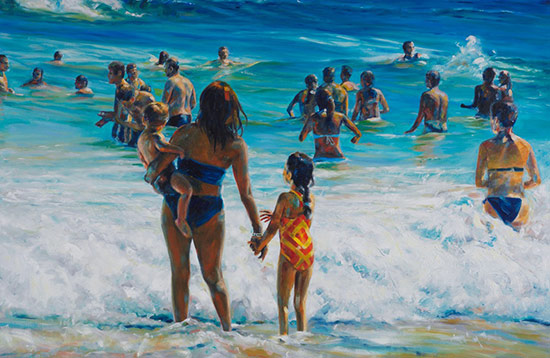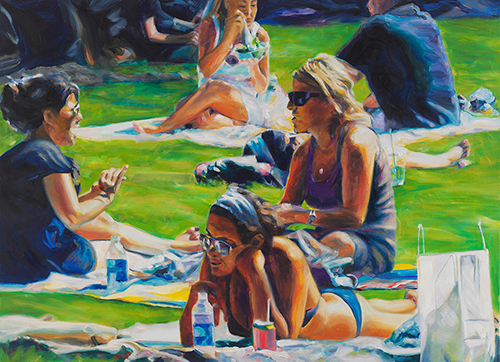Summery-lush park vistas flooded with light, people at leisure, vacationers at the refreshing water, sitting in gardens between dapples of sunlight, but above all the ever-recurring fruit baskets and flowers, in bouquets and beds: these are the subjects-almost sprung to life from the late 191h century-in the paintings of Jürgen Schmiedekarnpf. Paradoxically, with them he has again taken a step closer to reality. The optical fractures built into his earlier paintings seem to have vanished. That which is real, the findings of the eye, is no longer relativized by inscribed abstract patterns. The sensuous element of painting is no longer domesticated by erudite allusions to the history of art and painting.

Schmiedekampf again lives painting to the full.
Here his red-cheeked apples do not disclaim their origins in Cezanne, and his robust grapes almost ostentatiously take their place in the great tradition of Dutch still-life painting of the Golden Age. Yet by reveling in the luxuriousness of fruit, materials and ingredients, in the glowing delights of the table, he quotes-and at the same time goes beyond- his models: Jürgen Schmiedekampf offers more than just painted references to Veldzquez and Delacroix, Corinth and Kokoschka. He looks back without epigonously longing to be back, he quotes, paraphrasing openly without copying freely. For it becomes quite clear that his primary concern is to move color on the canvas in his own way; eschewing stylistic contortions and sudden impulses, he positions, differentiates, arranges, in short: composes.
I paint, therefore I am.
If in so doing Schmiedekampf brings the joys of the palate into the picture, then eating and drinking are nothing more than an indirect intention. He has a slightly different sort of gourmets in mind. His target group are lovers of painting, In the age of electronic media, computer-generated images, anyone who today still (or once more?) takes up a brush really should no longer have to give any reasons for doing so. Painting, that is, the hand-worked production of stationary images instead of those which flicker and are gone, has so clearly become an historical form of expression that it no longer needs to be discussed in the act of painting itself. Nowadays, anyone who paints is no longer celebrating a particular tradition, is not the guardian of anything academic or defending endangered cultural values. Schmiedekampf’s statement is therefore very simple, very direct: it is the celebration of painting itself, actively handling the beautiful material of paint to appeal to the human senses, to play with associations and synesthesia-what in common parlance is called a feast for the eyes.
Painting is “a feast for the eyes”
noted Eugene Delacroix in his diary two hundred years ago, toward the end of his life. This not only paved the way for such painters as Courbet and Manet, but also for the Impressionists and Expressionists, indeed for all of modern art. Painting as a feast for the eyes-that is also the motto of Schmiedekampf. With each painting he seems to breathe in and out more freely: here am I a painter, here a painter may be. Much like the German student of Morandi, Klaus Fussmann, he also does not shy away from what might be considered kitsch. Flowers in bloom and laughing apple cheeks, red lobsters and blue grapes-what can be said against that?

When it is given with love and delicacy, skillfully handcrafted, neither superficially virtuosic nor fretfully spelled out, but instead free and unconstrained, Schmiedekampf addresses the viewer with exactly the same directness. Visible things, the worlds of still-lifes, the tangible, touchable, all serve in his free painting as material insurance, as a link back to life itself. This holds true for his landscapes, flooded with light and warmth, his parks and summer-fresh paintings as well as for his figures and nudes.
In the age of atomic fission and the theory of relativity, modern art has contributed in shattering the old Newtonian view of the world. It pushed forward-first with the invention of abstraction and later of concretion-into areas hitherto invisible. Yet with all due respect to the achievements of this modern movement-incidentally, now quite weary-there is today no longer any index of forbidden painting dictated by ruling ‘isms. Art is freer than ever, but also more diffuse. Schmiedekampf knows this, He is not a naive painter. At the back of his paintings there is also, and not least, the melancholy insight of the writer Robert. Walser, who remarked as early as the beginning of this century that indeed every thought has already bean thought, every line has already been written. Nonetheless, the desire to write has no more faded that the passion to paint. Even if the world were to end tomorrow, Jürgen Schmiedekampf would still paint a picture today.
